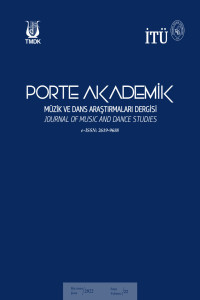Ali Rifat Çağatay'ın Koleksiyonundakı̇ Hdef 8 İsimli Hamparsum Defterinde Yer Alan Günümüz Notasına Çevrilmiş Nakış Biçiminde Bestelenmiş Eserlerin Biçim Analizi
Müzikte biçim, eserlerin yapısını ifade eder. Bu ifade etme yöntemi örgütseldir. Örgütlenme ise eserleri kendi içerisinde gruplandırmaya iter. Türk müziğinde biçimler her ne kadar kalıplara sokulmaya çalışılsa da bu kalıplar bütün müzikal yapıları kapsamamaktadır. Nitekim nakış biçimi de bu ölçüde sayılabilir. Türk Dil Kurumu’na (TDK) göre “nakış” kelimesinin müzikteki anlamı “Beste ve semainin, dört yerine iki haneli olanı”, mecazi olarak ise “hile” anlamlarına gelmektedir. Arapçadan nakş ve Türkçe ’deki etmek fiilinin birleşmesi ile oluşan nakşetmek ise “süslemek, bezemek ve nakış yapmak anlamlarında kullanılmaktadır. Nakış bir besteleme biçimi olduğu söylenebilir. Temel olarak iki hane ve terennümlü, icra açısından biraz “hileli” ve uzun terennüm bölümleri ile adeta süslenmiş, nakşedilmiş bir yapıda olduğu düşünülebilir. Ali Rifat Çağatay’ın arşivi 2011 yılında Alp Altıner tarafından Nilgün Doğrusöz Dişiaçık ile paylaşılmıştır. Nilgün Doğrusöz Dişiaçık’ın kurucusu olduğu Osmanlı-Türk Müziği Araştırmaları Grubu “OTMAG” tarafından arşiv inceleme çalışmaları başlatılmıştır. Ali Rifat Çağatay’ın arşivinde bulunan ve çeviri yazısı yapılan “HDEF 8” isimli defter Hamparsum müzik yazısı ile yazılmıştır. Ali Rifat Çağatay’ın koleksiyonundaki HDEF 8 isimli defterin içerisinde yer alan nakış biçimindeki eserler incelenmiştir. Defter içerisinde yer alan nakış eserler farklı dönemlerden farklı bestekârların eserleridir. Eserlerin melodi ve güfte arasındaki bağlantıları incelenerek biçim analizleri yapılmıştır. Eserin içerisinde ayrılan bölümler güfte ve melodi üzerine seçilmiştir. Melodiler A1m, B2m ve AT gibi farklı kodlar verilerek isimlendirilmiştir. Konuya ışık tutması bakımından nakış biçiminin farklı kaynaklardaki tanımlarına değinilmiştir. HDEF 8 isimli defterin içerisinde yer alan 20 adet nakış biçimindeki eserden 19 tanesinin biçim analizleri yapılarak biçim şemaları tespit edilmiştir. Analiz sonucunda 19 eserde 18 adet farklı kullanım olduğu saptanmıştır. İki adet eser “Cesm-i bed-kes be-cesm-i mestet ne-rezed” ve “Dehr olmada bu sûr ile mahmûr-u meserret” ortak şema tespit edilmiştir. 19 eserden elde edilen istatistikler kullanılarak en çok kullanılan bölümler ve şemalar tespit edilmeye çalışılmış ve yorumlanmıştır.
Anahtar Kelimeler:
Nakış Biçimi, Biçim ve Form, Ali Rifat Çağatay, Hamparsum, Biçim Analizi
Form Analysis of the Works Composed in the Nakış Form Transformed to Western Notation in the Hamparsum Notebook Named HDEF 8 in Ali Rifat Çağatay’s Collection
In music, form refers to the structure which is the method of expression is organizational of works. This organization lead to the works to be grouped within themselves. In Turkish music, although these forms are trying to be put into patterns, these patterns do not cover all musical structures. According to the Turkish Language Society, the meaning of the word "nakış" in music is "the one with two hanes instead of four of the beste and semai", and metaphorically it means "trick". Nakış, which is formed by the combination of the verb “to nakş” word in Arabic and the verb “to do” in Turkish, is used in the sense of "to decorate, and to embroider. Basically, it can be thought that it is a nakış structure with two hanes and terennüm, and a bit "tricky" in terms of performance, and almost embellished with long terennüm sections. The notebook titled "HDEF 8" in the archive of Ali Rifat Çağatay was written with the note Hamparsum. Archive of Ali Rifat Çağatay was shared with Nilgün Doğrusöz Dişiaçık by Alp Altıner in 2011. The study of the archive started with by the Ottoman-Turkish Music Research Group called "OTMAG", founded by Nilgün Doğrusöz Dişiaçık. Among these initiatives, many works have survived to the present thanks to the "Hamparsum note” developed by Hamparsum Limonciyan. In this study, the works in the form of Nakış in the notebook named HDEF 8 in Ali Rifat Çağatay's collection were examined. The sections separated in the work have been chosen on the lyrics and melody. The reserved melodies are named differently such as A1m, B2m and AT. When we look at the number of measures in the sections in the form schemes of the works, it has been determined that the long A chant sections are the sections that have the most measure in the work. Among the 19 works, only the formal analysis of “Cesm-i bed-kes be- cesm-i mestet ne-rezed” and “Dehr olmada bu sûr ile mahmûr-u meserret” were common. By examining the connections between the melody and the lyrics of the works, their form structures were revealed. In terms of shedding light on the subject, the definitions of the nakış form in different sources are mentioned. The analysis of the 19 of the 20 works in the notebook called HDEF 8 and the definitions of the existing nakış forms were examined and determined. By using the statistics obtained from 19 works, the most used sections and diagrams were tried to be determined and interpreted.
Keywords:
Nakış, Ali Rifat Cagatay, Hamparsum, Notation, Form Analysis,
___
- Akdoğu, O. (1995). Türk Müziğinde Türler ve Biçimler. Ege Üniversitesi Basımevi.
- Altınel, Çoban, N. Y., Karadeniz, Ş. (2020). Hamâmîzâde İsmâil Dede Efendi’nin 25 Murabba Bestesinin Biçim Analizi. İdil, 1715–1737.
- Doğrusöz, N. (ed.) (2019). Ali Rifat Çağatay’ın Arşivi I: Envanter. OTMAG Yayınları. http://www.otmag.itu.edu.tr/yayinlar/ali-rifat-Çağatay/ali-rifat-çağatay%27ın-arşivi-i-envanter
- Doğrusöz, N., Ergur, A. (2017). Musikinin Asri Prensi, Gece Kitaplığı.
- Özalp, M. N. (1992). Türk mûsikîsi beste formları. TRT Basın ve Yayın Müdürlüğü.
- Öztuna, Y. (2000). Türk Musikisi Kavram ve Terimler Ansiklopedisi. Atatürk Kültür Merkezi Başkanlığı Yayınları.
- Karadeniz, Ş. (2019). Haza Mecmua-i Saz ü Sözde Türler ve Biçimler, Gece Akademi, İstanbul.
- Yavaşça, A. (2002). Türk Mûsıkîsi'nde Kompozisyon ve Beste Biçimleri. Türk Kültürüne Hizmet Vakfı.
- Başlangıç: 2010
- Yayıncı: İstanbul Teknik Üniversitesi
